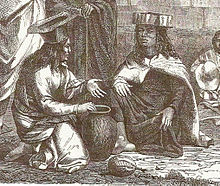Atacama people
| kunzas, or likanantaí | |
|---|---|
 |
|
| Total population | |
| 30,000 | |
| Regions with significant populations | |
|
|
21,015 (2002) |
|
|
13,936 (2010) |
| Languages | |
| Kunza, Spanish | |
| Religion | |
| Christian, Inca cult | |
The Atacama people, known as atacameños or atacamas in Spanish and kunzas, likan-antai or likanantaí in the native language, are an indigenous people from the Atacama Desert and altiplano region in the north of Chile and Argentina and southern Bolivia.
According to the Argentinean Census in 2010, 13,936 people identified as first-generation Atacameño in Argentina, while Chile was home to 21,015 Atacameño people as of 2002.
The origins of Atacameño culture can be traced back to 500 AD. At the start of the 15th century, the Atacameño were conquered by the Inca Topa Inca Yupanqui, who introduced a new social order, the Inca sun cult and various customs including coca leaves. The Inca regime constructed roads from the Salar de Atacama to what is now north east Argentina.
In 1512, the first Spanish conquistadors arrived in the area and it was finally annexed under Spanish control in 1556. In the 18th century, the Atacameño Tomás Paniri joined the uprisings led by the Peruvian Túpac Amaru II and the Bolivian Túpac Katari. In 1824, the region became part of Bolivia and in 1883 fell into Chilean hands. In 2007, the Atacameño population was estimated at 21,015 people.
The Atacameños protected their villages with strong stone walls known as pukara, a Quechua word. They also developed ceramic crafts, copper work (using copper extracted from Chuquicamata) and gold work. Many of the historic villages still exist today with the same names, including Quitor, Chiu-Chiu, Lasana, , Topayín, Susques, , , Antofagasta de la Sierra, and one of the most important settlements in the region, San Pedro de Atacama.
...
Wikipedia
